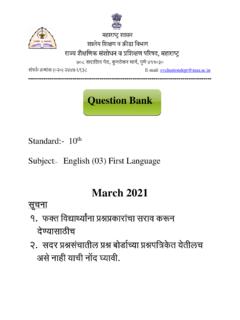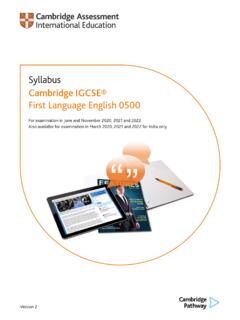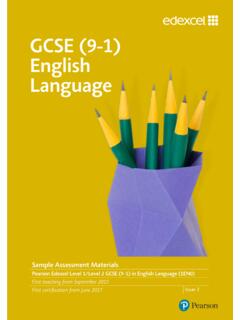Transcription of A Level English Language - Edexcel
1 A Level English Language Guide to Issues, Concepts and Theories artwork: Mark Bolitho | Origami photography Pearson Education Ltd/Naki Kouyioumtzis 2 Content page Page Introduction 3 Why should students use theory? 3 How do students use theory? 4 Exam tips 6 What theory? 6 3 Note from the Pearson English Team We hope that you find this guide helpful when delivering our A Level English Language qualification. We are intending to add exemplar work to this guide after the Summer 2019 exam series to exemplify good practice in relation to issues, concepts and theories. Introduction This guide has been produced to help teachers of A Level English Language show their students how best to handle theories of Language study, and the theorists associated with them.
2 The inverted commas in the previous sentence reflect the fact that the term theory is not straightforward in its application. The first part of this guide outlines the role of theory in the study of A Level English Language why students need to know about it. The second part discuss the kinds of reference to theory that examiners are able to reward highly, and approaches that are less successful how students should apply it. The third part briefly outlines a few examples of particular theorists and theory areas what students might refer to. Teachers have asked if Pearson Edexcel can produce a comprehensive list of Language theories and theorists that students should know.
3 This guide is in part a response to such requests, but it is crucial to recognise that (for reasons that should become clear in the next section) it would be counter-productive to attempt to produce a definitive list of theories or theorists, and the linguistic concepts and academics associated with them named in this document should certainly not be treated as providing a theory list that is either necessary on the one hand, nor sufficient on the other. Why should students use theory? It may come as a surprise that little direct mention is made of theory in the official documents that underpin this qualification. The prescribed subject content published by the Department for Education on which all current A Level qualifications are based makes no specific mention of the need to learn Language theories as specific subject knowledge.
4 Instead, it focuses on the need to introduce students to the concepts and methods of the disciplines of English Language /linguistics in relation to a wide range of spoken and written forms of English and to ensure that students contextual study of Language must be based on sound theoretical knowledge developed through a coherent course of study. 1 So theory should be seen not as a set of subject content for students to learn and repeat, but as the academic underpinning of the approach they take to the study and analysis of English Language . Similarly, the Assessment Objectives that apply to all A Level English Language qualifications make no explicit reference to theory at all.
5 AO2, which is often thought of as 1 GCE subject- Level conditions and requirements for English Language . (2018). Retrieved from 4 the theory AO requires students to Demonstrate critical understanding of concepts and issues relevant to Language use. These concepts and issues can include Language theories in the commonly understood sense of referring to the particular insights and approaches of named academics, but they are far broader than this, and the phrase relevant to Language use is particularly crucial here. Students will get little credit for knowing about a given Language theory, concept or issue, unless they can use it to illuminate their understanding of Language in use.
6 The approach taken by Edexcel in our specification and scheme of assessment is to encourage students to approach Language concepts and issues not as a body of knowledge to be learned and regurgitated, but as a set of tools to be used for critical analysis of Language data by using holistic mark-schemes that do not separate out marks for AO2, but instead place the AOs as linked strands that are interdependent. So, for students to apply appropriate methods of Language analysis required by AO1, they will have to identify relevant concepts and salient issues in the Language data under discussion, and use them to explore the meanings that are constructed by the Language in the light of contextual factors and the choices of Language features that are required by AO3.
7 Ensuring that students have a diverse toolkit of concepts and theories relevant to all aspects of the course will help them to select those appropriate to the given data under discussion, and that selection of the most useful analytical tools is one of the key indicators of a discriminating approach that is characteristic of Level 4 responses. If, in additional, students are able to demonstrate understanding of the strengths and limitations of the concepts and theories used, and are able not merely to select and apply them, but, where appropriate, to compare and contrast the effectiveness of different approaches to the Language data, and to apply them to analysis that is thorough, but nuanced, then they are likely to demonstrate a critical evaluative approach that is characteristic of the top of Level 5 in the mark schemes.
8 How do students use theory? Students are, of course, not expected to have the Level of understanding required for degree Level and they do not necessarily need to be introduced directly to high- Level academic primary sources. But equally, students should be encouraged to avoid simplistic, or even erroneous, presentations of linguistic theories and concepts. For example, students should: develop a sense of concepts and theories that are broadly accepted by academic linguistics understand that some concepts and theories are more contentious or polarising appreciate the way in which linguists develop, challenge and modify the ideas of predecessors appreciate theorists do not come up with ideas in isolation.
9 Such deeper and more nuanced understanding will help students to apply theory with the kind of critical and evaluative approach required at the high levels of the mark schemes. The main weaknesses that examiners see in students approaches to theory can be summed up as flaws in understanding theory, and weaknesses in applying it. Basic flaws in understanding can often come from students who are otherwise clearly very able, but 5 clearly have not grasped some of the key linguistic concepts and approaches they have encountered. Lower performing students chose superficial elements of the frameworks to comment on and did so with little development or depth, often with no theoretical discussion or overly explained theory that actually showed misunderstandings of core ideas or were irrelevant to the data.
10 Application of gender theory was often very descriptive and didn't enhance their analysis. (Examiner Report Paper 1, 2018) Another characteristic of lower performing students was a lack of clarity about the nature of the work of key researchers, or the source of the theory the theorist themselves as opposed to the writers of A Level text books or blogs summarising linguistic concepts The above issues are best illustrated by example. With regard to children s literacy development, the first Examiners Report on the child Language acquisition paper for the new qualification stated: Students are encouraged to explore theorists other than Kroll and Barclay when analysing written Language , while the 2018 report warns that Kroll is a very popular theorist among A Level students but not always the most useful for explaining why and how children develop literacy.













